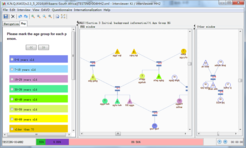KNQ2 - Computerised Kinship Network Questionaire
One of our main approaches is to combine ethnography with formal network interviews – applying a version of Rivers’ genealogical method and collecting detailed information about mutual assistance and other interactions among family network members. (The ‘genealogical method’ has been much criticised by socio-cultural anthropologists in recent decades for supposedly imposing western notions of biological kinship on other cultures. We think this criticism is unfair, and if taken literally would rule out a very powerful and flexible data-collection and analytic method.)
Our tool for conducting network interviews is the newly developed Kinship Network Questionnaire (KNQ2) – a software program for laptop computers. Originally developed at Max Planck Institute for Social Anthropology Halle (Saale) in conjunction with the EU-funded KASS-project the latest version incorporates a number of new features.

- The interviewer and informant look at this screen together during the interview.
- The diagram can be read two ways: either as people connected by family ties or as family unions connected by the individual people they exchange. (The interview collects data on both people and unions)
- There is also a space (on the right of the screen) for recording information about “important others” – people who are not genealogical relatives but are considered to be kin or kin-like.
The new KNQ2 consists of four subsystems:
- Questionnaire Management System enables researchers to design their own kinship questionnaire
- Interview Management System guides the interviewer and informant through the questionnaire
- Download and Variable Derivation (DAVD) – see right-hand panel
- Internationalisation enables the researcher to produce equivalent versions of the questionnaire in different languages
Data can be downloaded in three kinds of matrix formats:
- Data on individual people and their characteristics (including their interactions with the informant)
- Data on family unions and their characteristics
- Person-by-union data which can be used to work out network relationships
The data are downloaded as EXCEL-readable “txt” and “csv” files, which can be read by statistical packages such as SPSS and R – and also by network analysis packages.
A full description of the system is given in the attached PDF document.
